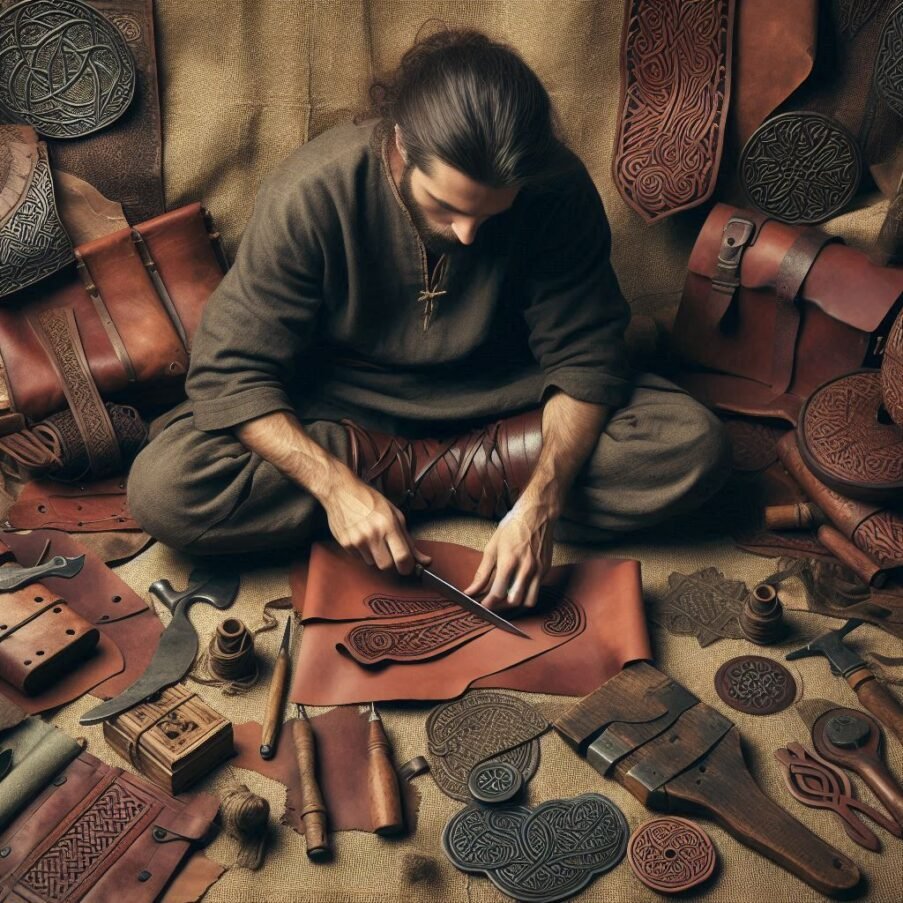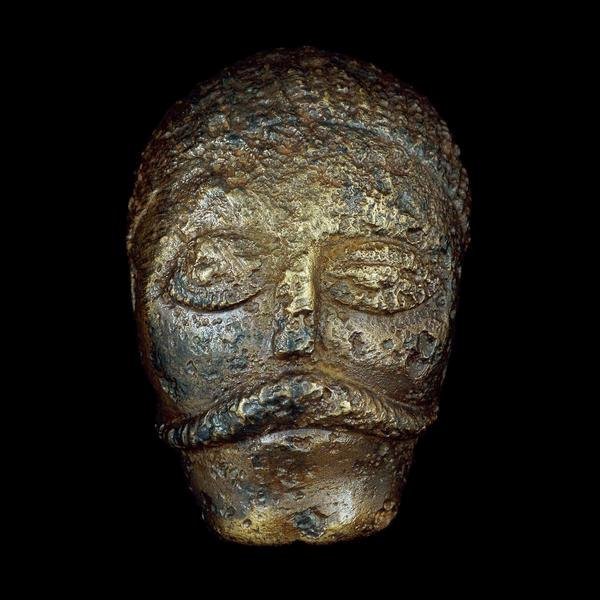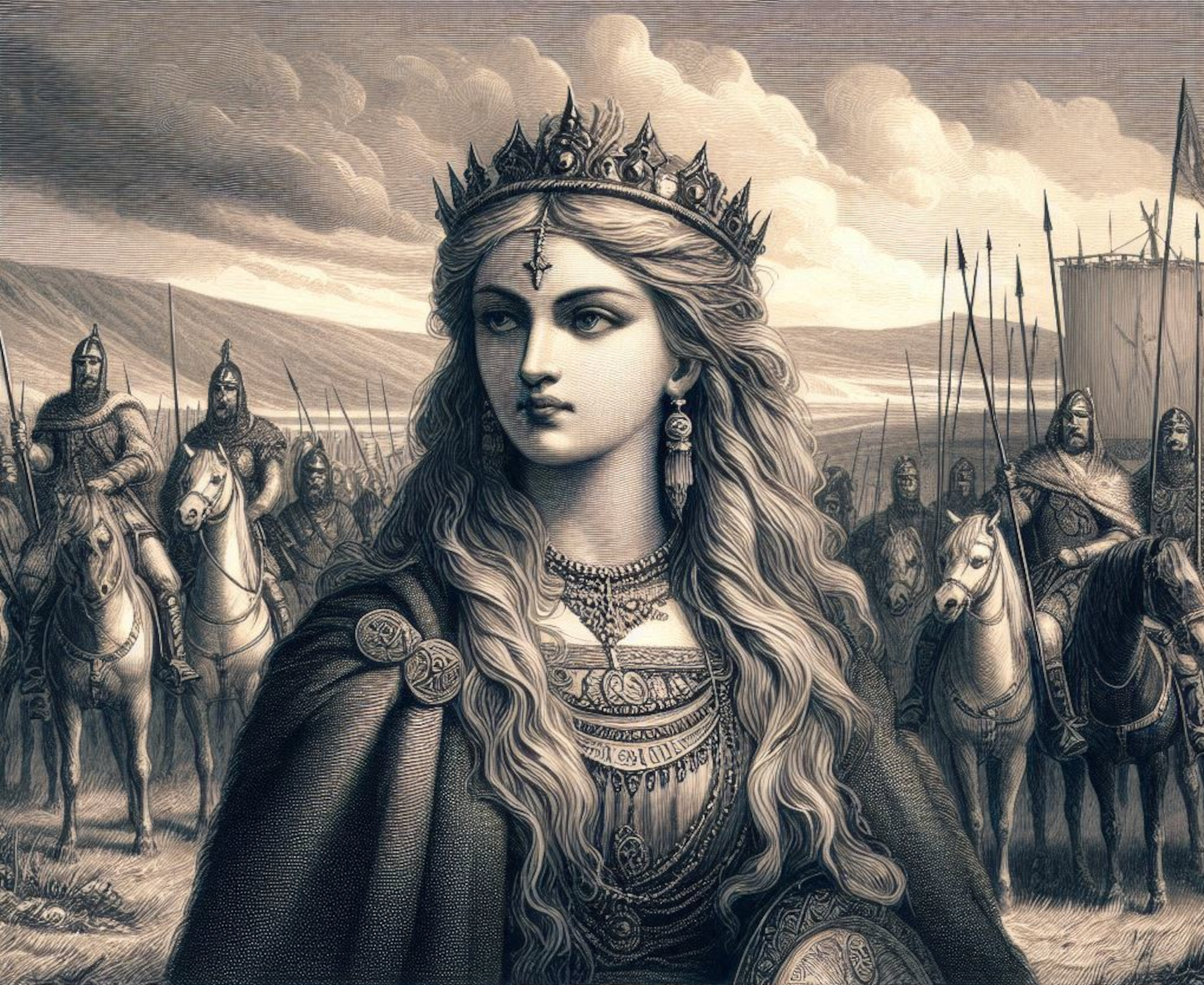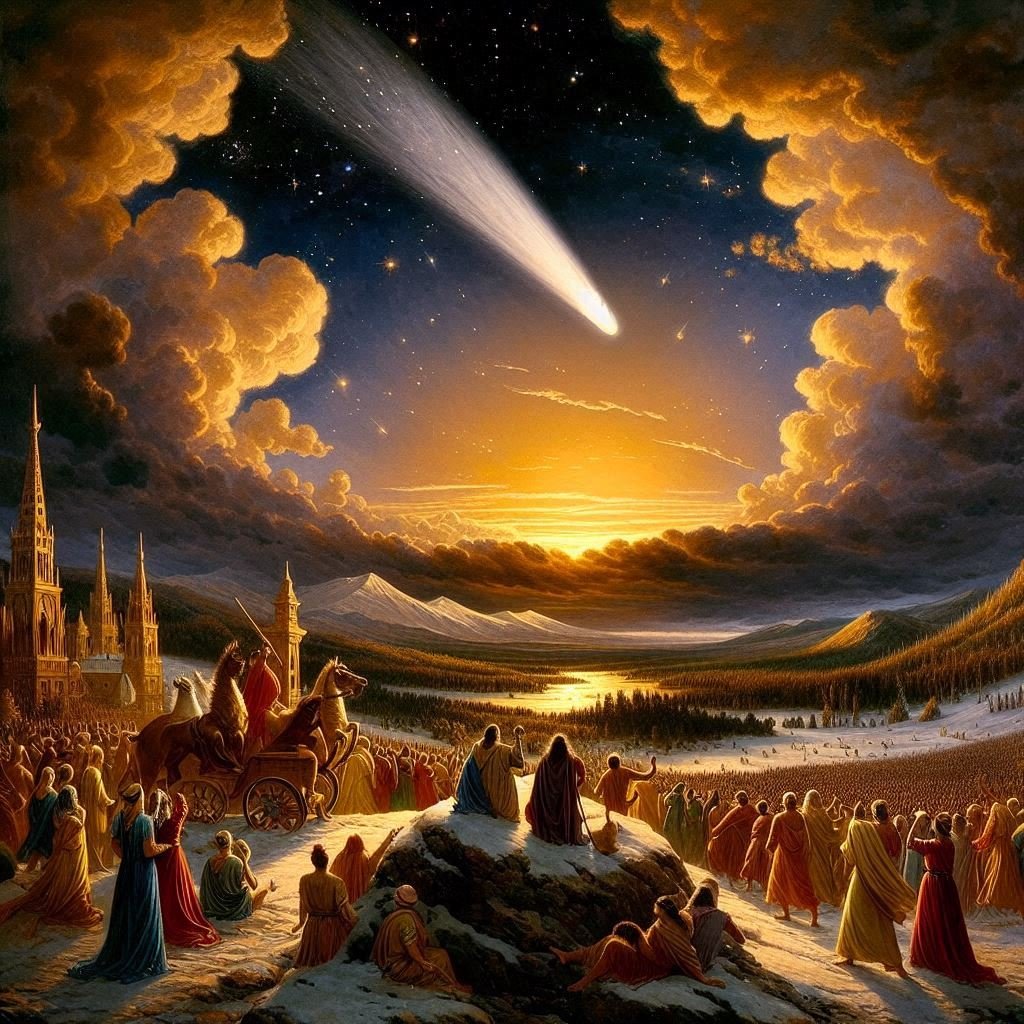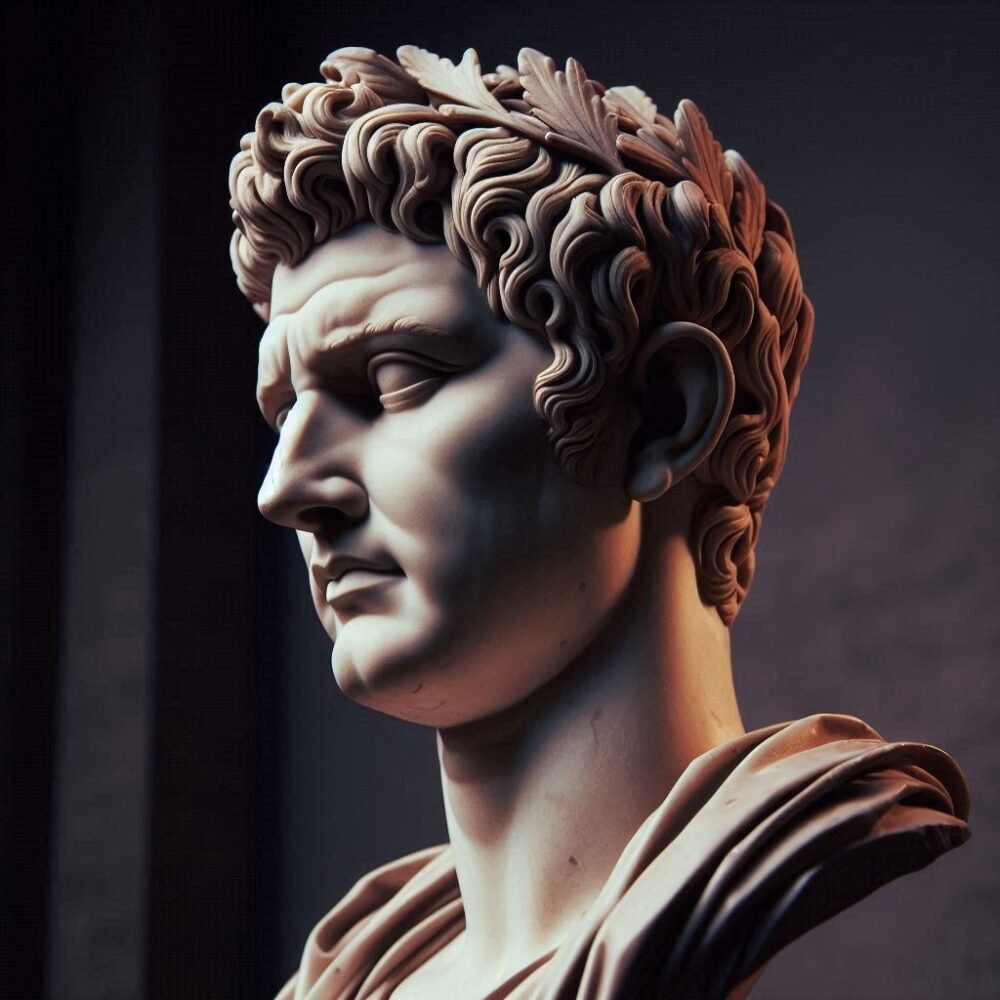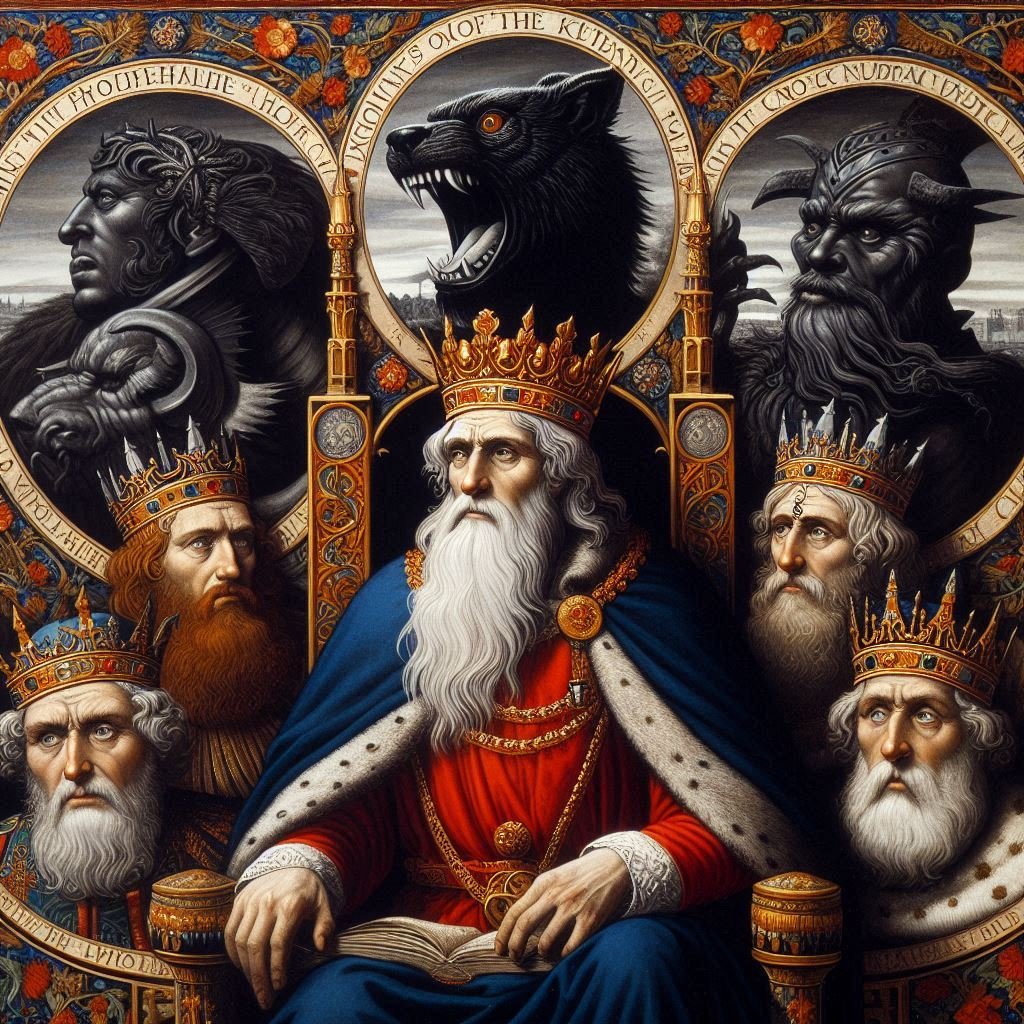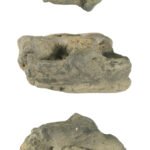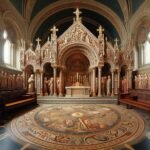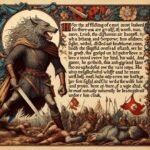Introduction
To look upon the tribes of Britain as just a bunch of savages is totally erroneous. Each tribe had thriving industries based on manufactured goods. Whether these goods were made in the homes of individual families, or in group workshops. The products of Celtic craftspeople were just as stunning as any Roman artefact.
Not all crafts were suitable to be carried out at home, so the more adventurous artefacts such as gold jewellery and metalwork were left to workshops equipped for such ventures. In the home, cloth was woven into various items and styles which could be sold on to traders, or directly to customers.
Woollen garments
The Celts kept sheep and goats for their hair and also food. What we do know about the woollen garments, is that they were highly sought after by the Romans. Owners of such items were considered to be in the height of fashion.
The wool was then transported to a home or workshop, where it was combed with plucking combs made from bone to turn this tangled mess into a form that made spinning and shaping the wool easier and to remove any loose deposits of soil etc. that may have contaminated the wool.
It was then cleaned and combed a second time, which made it soft and easy to weave. Then it was spun on a basic hand spindle.
After this, it was dyed using a vegetable-based mixture. As the Celts did not record the actual methods or constituents of the dying process, we can only guess at the ingredients and methods used. The same applies to the equipment they used. The spinning equipment was probably made from wood, and as such, any spinning weaves buried overtime and unearthed today would have perished beyond recognition. The combs they used have survived. Being made from bone, they endured the passage of time better than wooden implements.
Leather working
The procedure of making garments consisting partly or wholly of leather was one that could be undertaken as a home industry, if the craftsman was willing to take on a difficult and exacting process. Once the animal had been slaughtered, the stages involved from skinning to the finished product required a significant amount of skill and stamina.
The first step was skinning, whereby the hide was removed using large, highly sharpened knives and a knowledge of how to remove as large an area of skin in one piece as possible.
Next was the tanning process. Here the hide was prepared for shaping by immersing it in a vat or a pit filled with a soaking solution made from oak bark or galls. This caused the layers of fat on and in the hide to float off and rise to the surface, where it was skimmed off. Even these deposits of fat were used to in lamps for everyday lighting.
Then the leather was dried before the actual cutting, shaping and sowing happened. It was here the craftsmen would really come into their own. We have no knowledge of how the Celts knew the shape and size to make the garments, whether they used patterns, or used their own skill and experience. We do know they used knives to cut the hide and needles made from bone to sew the panels together. This is clear from the finds made, especially in the south-east of England.
Carpentry
Throughout time, the work of the carpenter has been fundamental to any society. In pre-Roman times, the woodworker was an essential part of any homestead. Homes, furniture, implements etc. used wood in their construction somewhere along the line.
The tools they used were similar to the ones used today, except they ran on people power rather than electricity. It was not just the skill of the craftsmen that was essential in word working. They also had to know the characteristics of each type of wood, how it could be used and its limitations.
Chariots
The Ancient Celts were known for their war chariots, which played a significant role in their martial culture. While the Celts did not invent the chariot, they adopted and adapted this technology to suit their needs. The chariot’s origins can be traced back to around 1700 BC, where the Hurrians of northern Syria transformed the four-wheeled Mesopotamian war-wagon into a lighter, two-wheeled vehicle.
The Celts likely encountered the chariot as they spread across Europe, and by the 2nd century BC, they had become proficient in its use for warfare. Archaeological evidence suggests that the Celtic elite were buried with their chariots, indicating the high status of these vehicles. These chariots were typically light and fast, consisting of a platform with a waist-high guard at the front and sides, drawn by two horses.
The construction of these chariots would have required skilled craftsmanship, particularly in woodworking and metalworking, to create the wheels, frame, and fittings necessary for a sturdy yet swift war machine. The chariots would have been assembled using iron-rimmed wheels with spokes, a technology that provided strength and speed. The Celts’ use of chariots in battle was documented by ancient writers, who noted their effectiveness in combat. The chariots allowed for rapid movement across the battlefield, and the Celtic warriors were known for their ability to hurl spears and engage in close combat from these moving platforms. The creation of Celtic chariots was thus a sophisticated process that combined existing technologies with the Celts’ unique requirements for warfare.
Building structures
The Ancient Celts employed a distinctive approach to constructing their dwellings, which were perfectly adapted to their needs and the resources available in their environment. The quintessential structure was the roundhouse, a testament to their ingenuity. The construction process began with laying a circular foundation using wooden posts, which provided the structural support for the walls and roof. These posts were placed at regular intervals, creating a sturdy base for the subsequent layers.
The roofing poles, long and straight, were tied together at the top and fanned out to rest on each of the foundation posts. This radial layout was not only structurally sound but also allowed for an even distribution of weight and a spacious interior. The roof was then covered with thatch, typically made from locally sourced reeds or straw, providing excellent insulation and waterproofing.
For the walls, the Celts used a technique called wattle and daub. Wattle involved weaving sticks together to form a lattice, which was then covered with daub—a mixture of materials like clay, soil, and straw. This combination was not only effective in keeping out the cold, but also allowed the buildings to breathe, maintaining a comfortable living environment.
The interior of a Celtic house was practical and focused on the essentials. A central fire pit provided warmth and a place for cooking, while beds and seating were constructed from available materials. The Celts also paid attention to the drainage around their homes, often digging trenches to direct rainwater away from the structure, ensuring the longevity of their houses.
These ancient building techniques reflect a profound understanding of their environment and a sustainable approach to living. The Celts’ houses were more than just shelters; they were homes built with skill and care, reflecting the values and lifestyle of their inhabitants. Their legacy in architecture is still evident today in the remnants of their roundhouses and the archaeological insights they provide into Celtic life. The methods they used, while ancient, are a testament to their sophisticated understanding of construction and their ability to create enduring structures with the materials at hand.
In addition to their iconic roundhouses, the Ancient Celts were adept at constructing various other structures that were integral to their way of life. One of the most notable were the hill forts, which were primarily used for defensive purposes. These forts were often situated on elevated ground, providing a strategic advantage over the surrounding landscape. The construction of these forts involved large Earthworks, with walls built from stone or wood, and they often encompassed a complex of roundhouses within their boundaries.
The Celts also built burial monuments, which varied in form from simple cists covered with Cairns to elaborate passage tombs. These structures were not only places of interment but also served as ceremonial sites where various rites and rituals were performed. The construction of these monuments required an in-depth understanding of stonework, and often featured intricate carvings and alignments with astronomical events.
In their settlements, the Celts constructed communal buildings such as feasting halls and workshops. These larger structures were central to the social and economic life of the community, serving as places for gathering, celebration, and trade. The design of these buildings was practical, focusing on the interior space needed to accommodate large groups of people and the activities that took place within.
Defensive walls, both around settlements and as standalone structures, were another aspect of Celtic construction. These walls, known as ramparts, were made from earth, stone, or a combination of both, and were designed to protect against invasions and raids. The techniques used in building these fortifications were advanced for their time, demonstrating the Celts’ skill in engineering and construction.
The Celts’ architectural legacy is evident not only in the physical remnants of their structures but also in the cultural impact they have had on subsequent generations. Their buildings were constructed with a profound respect for the landscape and resources, and their techniques have been studied and admired for their sustainability and harmony with nature.
Metalworking
Unlike the crafts mentioned above, metalworking meant the base material had to be manufactured before it could be shaped. This was one craft that could not be carried out at home and was mostly performed by a team of craftsmen in a central location. It should be noted that the actual blacksmith was not usually performed as a home business, but the creating of the base iron in a furnace was carried out in many homes.
The main metal was, of course, iron. The minerals used to manufacture iron had to be extracted from mines, then transported to a smelting plant before being passed to the metalworkers. Iron was the main constituent for tools and everyday items, but bronze was also used. Silver and gold were reserved for ornate items of jewellery worn by the upper classes. Silver was used for items such as tableware by the nobility, whereas gold, from the mines in Wales, was primarily a metal used for decorative artefacts
The basic constituents of iron were charcoal and iron ore. These were powdered, mixed and placed in a shelf in a small furnace. A fire was lit underneath, and this would have been tended for a day.
During this time, bellows were used to pass air into the furnace from below and out a chimney at the top. When the temperature inside reached 800 degrees Centigrade, a process of oxidization took place, which caused the slag to separate from the iron and run off the shelf to the bottom of the furnace.
The finished iron blocks were passed to the blacksmith, who manufactured them into tools and weapons for the tribe.
Jewellery
The creation of Celtic jewellery was a complex process that involved various techniques and materials, showcasing the Celts’ deep connection with their culture and the natural world. The earliest known Celtic art, the Hallstatt style, emerged around the 12th to 8th century BC, characterized by geometric patterns and symmetrical designs executed primarily in metalwork. This period’s prosperity, based on salt mining, allowed for the development of impressive metallurgical skills.
As the Celts expanded across Europe, their art evolved into the La Tène style around 500 BC, marked by more sophisticated designs with intricate knotwork, spirals, and zoomorphic motifs. These designs often held spiritual significance, representing the Celts’ beliefs and their observations of nature and the cosmos. The La Tène period also saw the Celts’ craftsmanship flourish, with jewellery pieces becoming more elaborate, incorporating gold, silver, and precious stones to signify status and wealth.
The techniques used by Celtic artisans included filigree and granulation, creating delicate and ornate items that reflected the richness of their culture. Filigree involved twisting thin wires of metal and soldering them onto the surface of an object to form intricate patterns, while granulation entailed the use of tiny beads of metal to create textured designs. These methods required a high level of precision and artistry, indicating the Celts’ advanced knowledge in metalworking.
Celtic jewellery often served multiple purposes: it was a symbol of protection, a sign of social status, and a means to express personal identity and beliefs. The use of various metals like gold, silver, and bronze, sometimes combined with enamel, allowed for a diverse range of colours and patterns, which were further enhanced by the Celts’ skill in hammering, casting, and engraving. The resulting artefacts, from torcs and brooches to bracelets and necklaces, were not only beautiful but also imbued with cultural and spiritual meanings.
The Ancient Celts utilized various materials to create their distinctive jewellery, reflecting the resources available to them and their advanced metallurgical skills. Metals such as gold, bronze, and silver were commonly used, prized for their durability and lustre. Gold, often hammered into thin sheets, was a favoured material for high-status items, adorned with intricate patterns through techniques like embossing and chasing, creating motifs such as zigzags, triangles, and diamond shapes. Bronze, known for its hardness and darker hue, was typically used for items like brooches and belt buckles, which required a robust material that could withstand frequent use.
In addition to these metals, the Celts also incorporated various precious and semi-precious stones into their jewellery, including amber, jet, and Shale. Amber, with its warm, translucent glow, was often used as inlay or for beads, adding a touch of colour and light to the metalwork. Jet, a type of lignite with an intense black sheen, was highly valued for its reflective qualities and was carved into intricate shapes for adornment. Shale, another type of sedimentary rock, was also shaped and polished for use in jewellery, providing a smooth, dark surface that contrasted beautifully with the bright metalwork.
Enamelling was another technique employed by the Celts, where powdered glass was fused to the metal surface at high temperatures to create vibrant, colourful designs. This allowed for the addition of reds, blues, greens, and yellows to their jewellery, further enhancing the visual impact of their pieces. The use of enamel was particularly prominent in the La Tène period, where the artistic expression of the Celts reached new heights with more complex and abstract designs.
The craftsmanship of Celtic jewellery was not only about aesthetics but also function. Brooches, for instance, were not merely decorative; they served the practical purpose of fastening clothing. The design of these brooches often included a pin that was as much a work of art as the brooch itself, demonstrating the Celts’ ability to combine form and function seamlessly.
Weapons
Skilled Celtic smiths would forge weapons through a combination of techniques, including casting for intricate shapes and forge-welding, where multiple pieces of metal were hammered together at high temperatures to form a single piece. This method was particularly used for long swords, which were initially made of bronze and later of iron. The iron swords, although not as hard as steel, were effective due to their length and weight, allowing for powerful slashing attacks.
Swords and spears were the mainstay of Celtic warriors, and their construction was a reflection of the society’s values and technological prowess. The swords often featured elaborate decorations, with sheaths adorned in precious metals and intricate designs, signifying the status and wealth of the warrior. The Celts also developed different styles of warfare and weapons to suit these methods. For instance, in Spain, Celtic warriors became adept at close combat with shorter swords, while in southern Gaul, longer swords were preferred.
The quality of Celtic swords varied, with some being made of softer iron that could bend during battle, requiring the warrior to straighten them mid-fight. However, this depiction might have been exaggerated or misunderstood, as bent swords are often found in ritual deposits, suggesting a ceremonial purpose rather than a reflection of poor quality. The creation of these weapons was not just a matter of practicality but also of spiritual significance, with some weapons believed to be crafted by divine beings or imbued with mythical origins, adding to the mystique of the Celtic warrior culture.
Mining
They extracted these metals from the earth using primitive mining techniques that involved digging out shallow pits or following the veins of ore into the hillsides. The iron they produced was essential for making tools and weapons, which were used locally and traded with neighbouring tribes and even with the Romans after their arrival. Lead was used for plumbing and waterproofing, and its extraction was so extensive that the pollution from these ancient mines can still be detected in the peat bogs of the region today.

